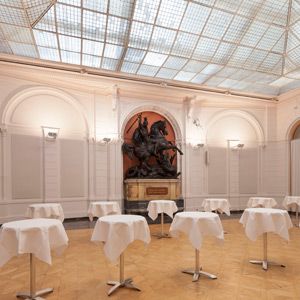At three locations in Vienna’s city centre, more than 400 employees of the OeKB group work hard in their areas of expertise to contribute to a successful and dynamic Austrian economy. The two buildings at Am Hof and in the Strauchgasse have an interesting history to tell. The location of the OeKB subsidiary Acredia is situated nearby in the Himmelpfortgasse.
OeKB location Am Hof
In the early 1950s, OeKB moved into its offices at the Am Hof 4, after operating offices at Heßgasse 6 in the initial years after its founding.
Here, where the OeKB is today, the “Pankrazkapelle” chapel once stood during the time of the Babenbergs, Vienna’s first castle chapel. In ancient times, this location was part of Vindobona, a Roman army camp.
Constructed as a bank building in 1913
he current building was erected as a bank building by the “Zentralbank Deutscher Sparkassen” (central bank of German savings banks), based on plans by pupils of Otto Wagner, Emil Hoppe, Marcel Kammerer and Otto Schönthal.
For the construction, the houses at Am Hof 3 and 4 were torn down, including the building of the papal nunciature, where the former Pankrazkapelle was located, and a newer building from 1876.
show moreUntil OeKB moved its current office, it experienced an eventful history: after the “Zentralbank Deutscher Sparkassen” collapsed in the interwar period, the building was taken over by the “Vaterländischen Front” (Patriotic Front), founded by Engelbert Dollfuß, in 1934.
In March 1938 the building was handed over to the National Socialists without a fight, and served as a location for the Gauleitung (district administration) of Vienna. When the Gauleitung moved into parliament, the building was used for offices. It was provisionally under the ownership of Austria until it was incorporated into the German Reich in 1941. Since 1948, the building has been the property of the Republic of Austria and, alongside OeKB, also accommodates various other tenants.
The building at Am Hof
Die OeKB in der Strauchgasse 3
The current OeKB location, at Strauchgasse 3, is where the Ottakringer brook once flowed, bordered by shrubs (Sträucher) that gave the street its name. In the mid-19th century, William Albert, 1st Prince of Montenuovo, bought all the property, including the buildings along the Strauchgasse, and had a Mietpalais of over 2,600 square metres constructed in 1851/52. For its courtyard, the sculptor Anton Dominik von Fernkorn created a magnificent, bronze equestrian statue of St. George.
Seat of the Anglo-Austrian bank for 80 years
The 1st Prince’s family used the Beletage and rented the other space out. In 1864, the Anglo-Austrian bank moved into a section of the building and housed its headquarters there for over 80 years. In 1971, the Anglo-Austrian bank bought the palace, converted it and put a roof over the courtyard, which from then on served as a cashier’s hall.
In 1930, the Creditanstalt took over the financial institute and the building was turned into a block of offices. During the period of National Socialism, the “Processing Centre of the Property Transactions Office of Vienna” was located here. In 1944, two bombs destroyed large parts of the building.
Location with “green building” standard
Just like the former Anglo-Austrian Bank, OeKB moved into the Mietpalais as a tenant in 1959, eventually buying it in 1981. During a renovation of the façade, new office rooms were also added. The adapted building blends harmonically into the cityscape, and achieves the “green building” standard that is so rare for old buildings.
But the Palais is not just a workplace: The Reitersaal, located at ground level - the former inner courtyard and cashier’s hall - with its impressive Fernkorn sculpture and the painstakingly renovated glass roof with 14,660 individual glass panes, is a popular location for events in Vienna’s city centre.



























